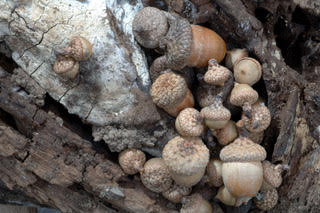
|
COLUMBUS, Ohio – The 2020 acorn abundance survey conducted on 38 wildlife areas throughout Ohio shows an above-average year for red oaks and a below-average year for white oaks, according to the Ohio Department of Natural Resources (ODNR) Division of Wildlife. Ohio’s fall acorns are an important food source for more than 90 forest wildlife species, and mast crop distribution can influence hunting plans. The acorn mast crop is the number of nuts collectively produced by trees.
Division of Wildlife employees scanned the canopies of selected oak trees on wildlife areas to determine the percentage of trees that produced acorns and the relative size of the acorn crop. Results showed that an average of 27% of white oaks and 70% of red oaks bore fruit this year. Over the past five years, acorn production has oscillated. For the second year in a row, red oaks were well above the 16-year average, while white oaks were below average.
In addition to determining the presence or absence of acorns, observers estimated the percentage of each tree’s crown that was covered with acorns. Average crown coverage of acorns for white oaks was 6%, slightly above the 2019 total but below the long-term average of 9%. Average crown coverage for acorns for red oaks was 32%, an increase from last year and well ahead of the long-term average of 20%.
Wildlife prefer white oaks because red oaks acorns contain a high amount of tannin and taste bitter. White-tailed deer, wild turkeys, and squirrels concentrate near areas with heavy crops of white and chestnut oak acorns.
Acorns are an important food source for many forest wildlife species. Numerous studies have linked the abundance of mast crops to body condition, winter survival, and reproductive success of white-tailed deer, wild turkeys, black bears, gray squirrels, and ruffed grouse. Furthermore, hunters could use this information to key in on areas to improve hunting success.
In those areas where acorns are an important part of the deer’s diet, mast availability can affect deer movements and ultimately hunter success. In poor mast years, where deer are forced to use other food sources, travel distances between feeding and bedding areas may be longer and more predictable, making deer more vulnerable to harvest. This year’s mast crop may translate to relatively high hunter success rates in those areas where white oaks dominate.
This is the 16th year the Division of Wildlife has completed the acorn production mast survey. The results, including tables and historical numbers, can be found at wildohio.gov.
For more information about hunting in Ohio, download the HuntFish OH mobile app, available for iOS and Android, or visit wildohio.gov. Follow the Your Wild Ohio Hunter Facebook page for hunting tips and useful information as you get outside this season.
The mission of the Division of Wildlife is to conserve and improve fish and wildlife resources and their habitats for sustainable use and appreciation by all. Visit wildohio.gov to find out more.
ODNR ensures a balance between wise use and protection of our natural resources for the benefit of all. Visit the ODNR website atohiodnr.gov.
For more information, contact:
Brian Plasters, Division of Wildlife
(614) 601-3836